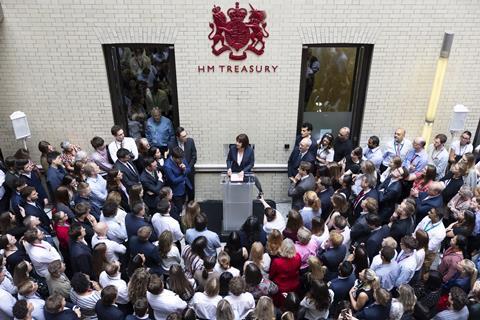Labour’s lack of spending options means ministers are looking again at the controversial private funding system designed to finance public projects off the government books. As part of Building’s new Funding the Future series, Joey Gardiner considers the chances of an unlikely renaissance for the much-maligned initiative

PFI: the so-called “unacceptable face of capitalism”. It is probably fair to say that the public image of the infrastructure financing mechanism never quite recovered from the Norfolk and Norwich University Hospital deal that was branded as such by Conservative MP Edward Leigh in 2006.

Then chair of the influential House of Commons public accounts committee, Leigh’s panel of MPs accused the consortium that built the hospital of making tens of millions of pounds by refinancing loans and not passing on the benefit to the hospital trust.
For many, the private finance initiative (PFI) system, invented under John Major’s Conservative government but turbo-charged under New Labour and exported around the world, has simply acted to boost the returns of private investors while landing cash-strapped public bodies with hugely expensive and inflexible liabilities. According to the latest Treasury figures, there remain £123bn of PFI payments to be made on existing signed deals, with payments running into the 2050s.
Currently, the public sector spends more than £10bn each year in unitary charges to pay back for a splurge on over 700 individual projects, mostly commissioned under Tony Blair and Gordon Brown, with a capital value of around £60bn.
When Philip Hammond cancelled PFIs’ successor, PF2, in 2018, he branded the model “inflexible and overly complex” (see panel PFI: How it works below). But that is to ignore the more visceral public distaste attached to the extravagant profits taken from some refinancing deals, or the vastly inflated charges recorded in some cases for simple maintenance such as the changing of light bulbs.
Despite all this, PFI’s advocates maintain the model in most cases worked well. And that – perhaps more persuasively – Keir Starmer’s government has little choice but to look to private capital if it wants the “national renewal” it has promised the electorate.
Several well-placed sources across the industry say the Treasury is now looking closely at developing a new private finance model akin to PFI – though it would certainly have a different name – to finance the construction it has planned. This is despite the fact that ministers arrived in the department last summer determined not to look again at PFI, and Treasury officials remain sceptical.
There have been clues that this change of heart on PFI is happening – with health secretary Wes Streeting in February telling the BBC that he was “open” to private finance being used to modernise the health estate.
The government’s 10-year infrastructure strategy due to be published in June will set out its approach to private investment, while its advisory group the British Infrastructure Taskforce is examing lessons from the previous version of PFI.
As part of Building’s Funding the Future campaign looking at how the cash-strapped government can attract funding to pay for public projects, we decided to look at the prospects for a new form of PFI. The wider story has not been written of what has prompted the government’s change of heart, and what is being considered – until now.
Beggars belief
That this Labour government is even looking at this is quite a turnaround, as it is difficult to overstate how politically unpopular PFI was seen to have become. While ministers have largely been silent on the issue, influential Labour backbencher Stella Creasy last autumn said PFI had been “a drag on the public finances for decades” and called for its cost to be put on the public books.
While in opposition, Labour MP Meg Hillier, said it “beggared belief” that the Treasury was unable to answer basic value for money questions about such deals.

Mark Baxter, MD of specialist services at contractor Galliford Try, which retains a significant investments division hosting its historic PFI projects, says: “I think the hurdles to new private finance in social infrastructure are far more political than they are practical.”
On top of this political antipathy, the growing issue of PFI “handback” has started to emerge as a serious problem in some areas: PFI deals that are reaching the end of their 25-year timeline, but where the private party and the public sector cannot reach agreement allowing responsibility for the asset to be handed back over.
A government report on the issue last year found that, unless changes were made, “the current trend towards increased disputes and deteriorating relationships [will] accelerate”.
Furthermore, the nation’s balance sheet position is not propitious. While PFI is structured in such a way that the private sector lends the capital required for construction projects, it does rely on a 25-year annual charge from revenue budgets to pay this back – the so-called unitary charge. Last month’s spring statement underlined just how little in the way of revenue funding the government has spare.
Simon Rawlinson, head of strategic research at consultant Arcadis, says: “The hard part is funding PFI. The nation’s finances show we are hard up when it comes to revenue spending. And that is really difficult for PFI models, which require revenue funding.”

In this context, it is perhaps hardly surprising that Richard Threlfall, global head of infrastructure, government and healthcare at advisory firm KPMG, says he was told by a senior minister last year that there were no plans for more PFI. “The government really doesn’t want to revive PFI if it doesn’t have to,” he says. “And the Treasury and the Infrastructure and Projects Authority have been still in the headspace of winding down their existing assets.”
All about the money
However, it is precisely the lack of money that is now, according to multiple well-connected industry observers, driving renewed government interest. While revenue funding constraints are a concern, they say, under PFI contracts the annual unitary charges of individual deals would be relatively small compared to the government’s financial constraints. In any event, the charges would not start until after new schools or hospitals open – meaning spending is significantly delayed compared to upfront capital construction.
PFI: How it works
PFI projects were first pioneered by John Major’s Conservative government from 1992 onwards. They are a form of public-private partnership structure designed to allow the private sector to finance the design, construction and maintenance for 25 years of public assets in return for the payment of an annual fee, called a unitary charge.
Key to the model is that the project is run by a private-led special purpose vehicle created for the project, often a joint venture of different firms including contractors, against which the finance is raised. This structure historically allowed the borrowing to stay off the public sector balance sheet, despite the ongoing contractual liabilities created.
At the end of the 25-year contract period, the assets are handed over to the public body. Under New Labour, the government paid PFI credits to support public bodies with the costs incurred by PFI projects, effectively incentivising them to use that route.
Steve Beechey, group public sector director at contractor Wates, says: “The point is private finance deals with the problem today, so they can starting getting things built. They wouldn’t start paying anything until the earliest autumn 2028, by which point they will hope the economy will be motoring.”
The immediate driver then is the need to finance Labour’s commitments to renew the nation’s schools, hospitals and prisons without the necessary capital budgets to make it happen. The spring statement once again saw the chancellor put more money into capital spending, but the vast majority of this – £6.4bn annually by 2029 – will go to fund the commitment to increase defence spending to 2.5% of GDP.
This means there is effectively no additional money, beyond that identified last November, for the plans set out in the January consultation on a 10-year infrastructure plan, for the “targeted replacement and maintenance of […] the existing primary care [health] estate”, “targeted replacement and maintenance of the education estate” and “managing prison capacity and maintaining the prison estate”.
Options
The former boss of PPP quango Infrastructure UK James Stewart, now chair of consultant Agilia Infrastructure Partners, says the government is looking very seriously at how it is going to deliver its pipeline of projects, with that analysis “including private finance options”.
He says the lowest hanging fruit will be projects with an independent revenue stream – hence government has already said it will consider private finance to pay for the £9bn Lower Thames Crossing project and the redevelopment of Euston station to support the arrival of HS2.

However, Stewart believes that, while no conclusions have so far been reached, consideration is also being given to using private finance for social infrastructure, where the borrowing would inevitably be at least in part funded by a public-sector-paid charge.
Stewart is not alone in believing this. Craig Elder, partner at law firm Browne Jacobson, says the issue was discussed in a call convened between Treasury officials and the Confederation of British Industry’s infrastructure group earlier this year. Listeners were left in no doubt that private finance was being considered not just for utilities and economic infrastructure with an independent revenue stream, but a model is also being looked at for new social infrastructure.
“It’s definitely being talked about,” Elder says, but adds he does not expect a major roll-out on the scale seen in the early 2000s. “I think there is going to be a model, but it won’t be all-singing all-dancing. More for certain specific projects that work.”
Wates’s Beechey says the idea seems to be that the government will give a final view alongside the launch of the 10-year infrastructure strategy earmarked for June. This is expected to be revealed on or around the same time as Rachel Reeves reveals the outcome of the spending review on June 11.
Around the spending review we think minsters will make some kind of definitive statement one way or another on a future PFI model. The government needs to decide once and for all
Stephen Beechey, group public sector director, Wates
“This is something they’ve been thinking about anyway, but the financial situation recently has got far worse,” Beechey says.
“Around the spending review we think minsters will make some kind of definitive statement one way or another on a future PFI model. The government needs to decide once and for all.”
This timeline is endorsed by two separate industry sources close to government, with one saying a key driver of government interest is to ensure that the infrastructure strategy they launch in June is credible. “Ministers initially said ‘no’ to a new PPP model, but they realise they are potentially cutting off a significant opportunity,” the source says.

“The big part of the infrastructure strategy is a project pipeline. But you can’t really have a credible list of projects if you don’t have a way to finance model to enable those projects to happen.”
The source says: “I think the politicians are now behind it, they back it. It’s the Treasury civil servants who are questioning it.”
James Stewart says looking at it makes good sense. A 2018 analysis of the costs and benefits of PFI by the National Audit Office found that such projects were more likely to be delivered on time and to budget, albeit service costs were often higher.
“PFI has a very good track record in the development and construction phase of projects,” Stewart says. ”The performance has been more problematic during the operational phase, but I believe changes can be made to the model that can address these issues.”
The government is simply unable to do the things it wants to if relying on public funding
Matt Bevington, policy associate, Future Governance Forum
And anyway, what choice does the Treasury have? Matt Bevington, policy associate at Future Governance Forum, which last autumn produced a report making the case for a new model of PFI, called Infrastructure Investment Partnerships, says: “The counterfactual is that the government is simply unable to do the things it wants to if relying on public funding.
“When money is short, it’s always capital that gets raided, and social infrastructure is worst hit. It is indefensible to build up an ever-increasing maintenance backlog and it’s a false economy.”
Asked detailed questions about a potential June announcement, a Treasury spokesperson did not deny it was being considered, and made clear that levering in private investment was being thought about in relation to the infrastructure strategy. They said: “As part of this government’s growth agenda, we will publish a cross-cutting, 10-year infrastructure strategy which will set out to investors and the supply chain our approach to private investment and infrastructure-related regulation.”
They added: “We have also committed to delivering an infrastructure pipeline to provide a clear sense of the government’s long-term priorities”.
What it could look like
So, if Treasury ministers are considering a new form of PFI, what are the options on the table? Commentators say any new model will be likely to learn the lessons of successor models to PFI, such as PF2 and the well-regarded Scottish and Welsh models NPD, Hub and MIM.
All of these more recent models cut out the provision of “soft” FM services from the PFI contract, given that those services were so often the subject of the early PFI “rip-off” horror stories.
The Scottish NPD, which stands for Non-Profit Distributing, tweaked PFI by including capped investment returns for the private sector, while the Welsh MIM, or Mutual Investment Model, enshrines delivery of community benefits in the contractual relationship and brings in the public sector as minority equity partner – while retaining “off balance sheet” status.
MIM, which is currently being used to deliver three major projects in Wales, is now being mooted by the Scottish government to build the £2.7bn A9 road dualling project.
>>See also: Building launches new campaign to look at funding projects in an era of constrained public finances
>>See also: How do we fund the future? How Building’s new initiative will look at options for financing public projects
Other PFI hybrids being talked about include the Precinct model used by the state of Victoria in Australia, in which a piece of new public infrastructure is used by private investors as an anchor investment for the regeneration of the wider neighbourhood. Ultimately, though, none of these contain fundamental differences to the core PFI model, which effectively guarantees public revenue to pay back private borrowing.
“You can put lipstick on it,” says Galliford’s Baxter, “but it’s still the same thing.”
A key difference, however, may be the type of scheme it is applied to. In England, at least, the messaging coming out of Treasury seems to be to not expect any new model to fund mega-projects.
“We got the sense it was not something for big-ticket projects, it’s more for everyday projects that this is being considered,” says Browne Jacobson’s Elder.
Stuart Murray, partner at law firm Brodies, says: “The discussion is about needing PPP back in the toolbox, for the right project for the right reasons. I’m not convinced there will be a big announcement without a pipeline of projects to go with it, more that they may use one of the PPP structures already available.”
For Mark Baxter, a focus on smaller projects would make a lot of sense, as his view is the PFI model does not handle well the big risks inherent in more complex schemes. The problem being that the PFI special purpose vehicles usually impose very tough sanctions on their contractors for late delivery, meaning that for trickier projects, contractors just price in far more for risk, thereby pushing up build costs.
Carillion collapse and the end of PFI
Conservative chancellor Philip Hammond scrapped PF2 in 2018 following the collapse of Carillion. Widely regarded as the UK’s biggest corporate failure in decades, the construction firm went under with debts of £7bn and the loss of thousands of jobs.
The firm was working on about 450 public sector projects, which were delayed and saw costs escalate as a result. These included the £475m Midland Metropolitan hospital in Sandwell, West Midlands and the £335m Royal Liverpool hospital.
The Royal Liverpool hospital eventually opened its doors to patients in 2022, five years after it was supposed to be finished, with construction work continuing into 2023.

Remember that £600m of losses on two PFI hospital projects were instrumental in sending contracting behemoth Carillion to an early grave in 2018. “If you start trying to apply PFI to major economic infrastructure, it’s just the wrong risk profile,” says Baxter.
“Likewise, it doesn’t work for major acute hospitals. But a simple revenue-financed model to deliver simple projects like schools and primary care is a no brainer.”
As to what the actual outcome will be, most observers believe it is genuinely still in the balance. Beechey says: “My guess is they will say they want to pursue it, but then they will spend a while developing what it is, and then pilot it. It’ll be a year before there’s a wider programme.”
Likewise, Future Governance Forum’s Bevington says that, while parts of the Treasury are “instinctively hostile” to a reformed PFI, he thinks the government will say it is exploring it at the spending review, in order to build a credible pipeline of projects.
Nevertheless, Baxter is not making any big bets on PFI any time soon. Galliford Try recently launched its sustainable growth strategy to 2030, but did not assume any income from fresh privately financed social infrastructure schemes.
“We’re really keen to do this,” he says. “But we’re not betting the shop on it. If it happens, it will be the icing on the cake” – rather implying that it won’t be the cake itself.
The rebirth of PFI has been talked up many times before, and Baxter’s position makes perfect sense. The question now is whether it will still be the right call after June.

Building’s Funding the Future campaign seeks to examine fresh ways of attracting and using finance to boost construction projects at a time of constrained public finances.
It will examine options for public-private partnerships that can draw on private capital to pay for large infrastructure projects, schools, prisons, hospitals and housing.
It will also look at existing models for private and public funding and examine how these can be optimised to ensure funding is efficiently spent and leads to more shovels in the ground as Keir Starmer looks to construction to boost flagging economic growth.
Over the next few months we will share learning, consult with industry and collect ideas from readers. This will culminate in a special report to be published at our Building the Future Live Conference in London on 2 October - click here to book your tickets now.
To share your ideas of new funding models, email carl.brown@assemblemediagroup.co.uk. To find the campaign on social media follow #Buildingfundfuture.


























No comments yet